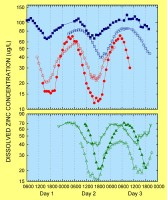Importance and Causes of Daily Variation in Metal Concentrations in Streams
 Fisher Creek in the New World mining district, Montana, near Yellowstone National Park. Fisher Creek is the site of a study of how chemistry changes as water moves downstream
Fisher Creek in the New World mining district, Montana, near Yellowstone National Park. Fisher Creek is the site of a study of how chemistry changes as water moves downstream
(Click on photo for larger version) |
|
In 2003, USGS scientists found that concentrations of some metals dissolved in stream waters fluctuate significantly on a daily cycle, and that this phenomenon occurs consistently across the northern Rocky Mountains. This finding had profound implications for studies evaluating metals contamination in mountain streams, particularly contamination associated with metals mining, which is extensive across the Rocky Mountains. Since 2003, further research has explored the extent and possible causes of these concentration variations. For example:
- All previous work on diurnal (daily) metal variations had been conducted during the summer, when working conditions are less difficult. The question then arose as to whether diurnal metal variations occur at other times. Repeated sampling at a site on Prickly Pear Creek, Montana, during a variety of seasonal conditions demonstrated that diurnal variations in metal concentrations occur year round and irrespective of the amount of flow in the stream.
- Pioneering research in the laboratory and field by a colleague and a University of Wyoming Ph.D. candidate demonstrated that photosynthesizing organisms living on the streambed of High Ore Creek, Montana, can create diurnal metal variations very quickly over a short reach of stream.
-
 Seasonal variation in dissolved Zn concentrations in Prickly Pear Creek near Helena, Montana, 2000-03. Data shown by blue squares were collected during winter low flow. Data in red are for high flows during spring runoff. Data in green are for summer low flow
Seasonal variation in dissolved Zn concentrations in Prickly Pear Creek near Helena, Montana, 2000-03. Data shown by blue squares were collected during winter low flow. Data in red are for high flows during spring runoff. Data in green are for summer low flow
(Click on photo for larger version) |
|
Sampling of three sites with very different pH conditions along Fisher Creek, Montana, demonstrated the downstream change in the nature of diurnal metal variations. In the headwaters, the stream is acidic (pH = 3.3) because it drains a partially mined mineral deposit. In this reach, iron is the only metal that exhibits diurnal variation. At the downstream site, the water is neutral (pH = 6.8), and metals such as copper, zinc, and manganese (but not iron) display diurnal variation.
These findings are important for designing field studies of metals contamination in mountain streams and for interpreting the processes that affect metals cycling in the environment.
References
- Morris, J.M., Nimick, D.A., Farag, A.M, and Meyer, J.S., 2005, Does biofilm
contribute to diel cycling of Zn in High Ore Creek, Montana?:
Biogeochemistry, v. 76, no. 2, p. 233-259. doi: 10.1007/s10533-005-4774-2
- Gammons, C.H., Nimick, D.A., Parker, S.R., Cleasby, T.E., and McCleskey, R.B., 2005, Diel behavior of iron and other heavy metals in a mountain stream with acidic to neutral pH - Fisher Creek, Montana, USA: Geochimica et Cosmochimica Acta, v. 69, no. 10, p. 2505-2516, doi: 10.1016/j.gca.2004.11.020.
- Gammons, C.H., Shope, C.L., and Duaime, T.E., 2005, A 24 h investigation of the hydrogeochemistry of baseflow and stormwater in an urban area impacted by mining--Butte, Montana: Hydrological Processes, v. 19, p. 2737-2753.
- Gammons, C.H., Woods, S.A., and Nimick, D.A., 2005, Diel behavior of rare earth elements in a mountain stream with acidic to neutral pH: Geochimica et Cosmochimica Acta, v. 69, no. 15, p. 3747-3758, doi: 10.1016/j.gca.2005.03.019.
- Lambing, J.H., Nimick, D.A., and Cleasby, T.E., 2004, Short-term variation of trace-element concentrations during base flow and rainfall runoff in small basins, August 1999, in Nimick, D.A., Church, S.E., and Finger, S.E., eds., Integrated investigations of environmental effects of historical mining in the Basin and Boulder Mining Districts, Boulder River watershed, Jefferson County, Montana: U.S. Geological Survey Professional Paper 1652-D7, p. 263-278.
- Nimick, D.A., Cleasby, T.E., and McCleskey, R.B., 2005, Seasonality of diel cycles of dissolved trace-metal concentrations in a Rocky Mountain stream: Environmental Geology, v. 47, no. 5, p. 603-614, doi: 10.1007/s00254-004-1178-x.
- Parker, S.R., Poulson, S.R., Gammons, C.H., and DeGrandpre, M.D., 2005, Biogeochemical controls on diel cycling of stable isotopes of dissolved O2 and dissolved inorganic carbon in the Big Hole River, Montana: Environmental Science and Technology, v. 39, p. 7134-7140.
More Information
Related Headlines
USGS Information on Contamination from Mining Activities
Back to Headlines Page
|

|